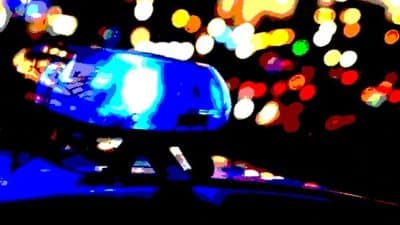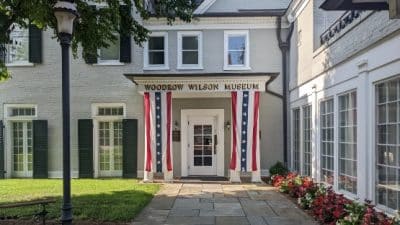![Park Woods Cabin was built in 1950 and has served the campus community as a gathering place for decades. It was refurbished in 2013 through collective efforts of students, alumni and physical plant staff and is now used for a variety of events, much as it was more than 60 years ago. (Photo courtesy of EMU Archives [left] and Kara Lofton)](https://augustafreepress.com/wp-content/uploads/2015/10/parkwoods-cabin_web-610x370-400x243.jpg)
But more likely, you know and remember…
Built as a gift by the classes of 1946 and 1950, Park Woods Cabin was the central hub of socialization and recreation on Eastern Mennonite University’s campus for more than 40 years. But over time, as recreation options diversified and Harrisonburg itself expanded, the cabin fell into disrepair, and eventually disuse.
In 2013, students hoping to preserve the cabin and use it again for recreational activities headed up a revitalization effort, including hiring a contractor to pull up asbestos floor tiles, installing a wood stove and fixing the leaky roof. In early fall 2015, the cabin was once more full with students fulfilling the cabin’s original intention: fellowship and socialization around good Mennonite food.
1950: Socials and meetings
In the late 1940s, before the cabin was built, “there wasn’t much doing in Harrisonburg for students,” said Laban Peachey ’52 who later served as dean of students. “The cabin was a very important place for social events.”
Around campus (EMC wasn’t actually in Harrisonburg in the ‘40s) there was little but cornfields and dirt roads. Most students didn’t have cars and even if they did, there wasn’t anywhere to go.
D. Lowell Nissley was senior class president in 1950. He and Jacob A. Shenk drew up the plans for the cabin, which included a native limestone fireplace built by a Harrisonburg local. “We [both the college and high school graduating classes] wanted to do something significant for the school,” he said. “The whole class worked on it on Saturdays when we had a chance.” The class named the finished structure Oakwood. Several years later, the college asked if they could use the name for a new men’s dorm and the cabin became simply “the cabin” and then Park Woods Cabin.
Laban Peachey was a freshman in 1949 and one of the first classes to actually use the cabin.
“In those days there were only about 250 students at EMC,” he said. “Groups of 10, 20, 30 people would use the cabin for class meetings and college socials. We would have marshmallows and hot dogs too – not very often, but sometimes.”
1960s: ‘The Bard’s Nest’
In 1966, the cabin began to be used as EMC’s first coffeehouse. The students, perhaps as a reflection of the folksy vibes of the ‘60s, named it “The Bard’s Nest.” Twenty years later, when (now) EMU English professor Chad Gusler was a student, the cabin was still used for that purpose.
“We would have open mic sessions, read music and host musical performances,” he said. “It was kind of like what Common Grounds is today, but cooler.”
Gusler likened the Bard’s Nest to a “dive bar” with regulars to whom they served birch beer or homemade hot chocolate. In the early ‘90s, the Nest added an espresso maker. Tables were lit with candles stuck in empty bottles and old burlap sacks served as backdrop to student artwork on the walls.
But by the time Gusler was on the scene, the building already had problems. There was no sewage or drainage tank on site and so no bathrooms. When it rained, the building sometimes flooded. The fireplace took more heat than it put out.
2000: the shift to University Commons
By August of 2000, the first phase of the University Commons was finished and Park Woods Cabin temporarily closed.
“University Commons shifted the focus of the university,” said Eldon Kurtz, director of the physical plant. “The Snack Shop was built with a stage in the corner intended to replace the Bard’s Nest, but it was never really used.”
In part that’s because shortly after, in December of 2001, EMU received a grant from the Lilly Foundation to build what is now the coffeehouse known as Common Grounds. “When Common Grounds came around, that met the need the Bard’s Nest had been meeting,” said Kurtz.
It also made the facilities issues down at Park Woods Cabin a little more glaring. But other projects, namely building new residence halls, took priority over the cabin and it was left empty for over a decade.
2013: New life
In February of 2013, EMU News published a plea: “We need your help in deciding the next step for Park Woods Cabin. There is student interest in improving the condition of the cabin, which is currently not in use.”
A carpenter’s guild, made up primarily of EMU alumni, stepped in and helped refurbish the cabin free of charge. The physical plant provided most of the materials; the students fundraised for the rest.
The cabin now boasts new flooring, a weatherproof roof, a woodstove instead of the fireplace and a clean chimney. A plaque in the wood paneling above the stove commemorates the cabin as a gift of the classes of 1946 and 1950. There is no longer running water (it was too difficult to maintain) and no plans to install pipes or a sewer system.
But on any given weekend, light can be seen spilling from the windows, once more giving the old building a feeling of new life. The most recent use: the Black Student Union hosted a jam session over Homecoming weekend.
– Story by Kara Lofton










